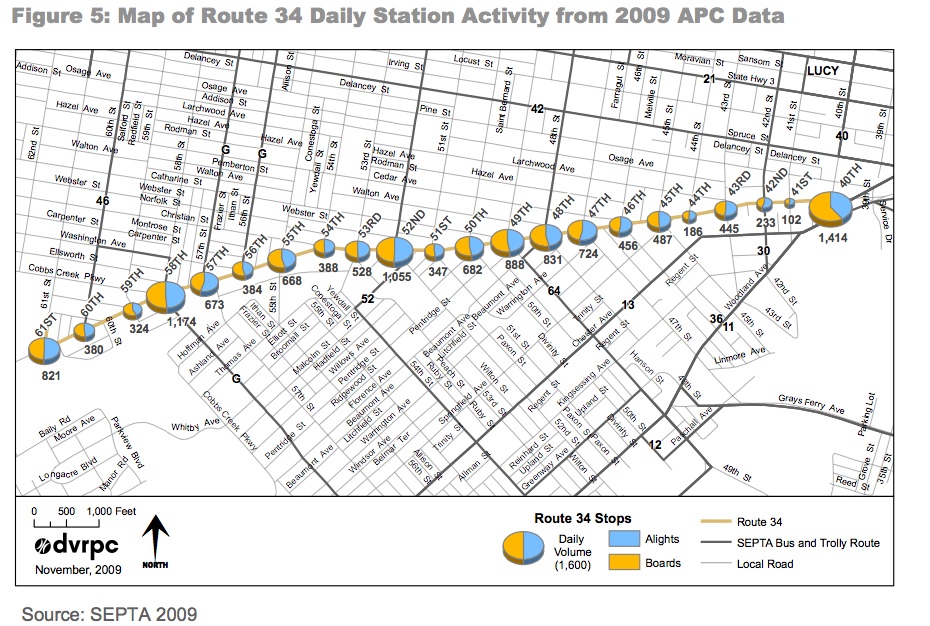West Philly issues crop up in Transit First trolley study

March 15, 2010
By Anthony Campisi
For PlanPhilly
Taking stops out of a transit route doesn’t always save riders travel time, according to a new study by the Delaware Valley Regional Planning Commission. The study, which examined the above-ground portion of the Route 34 trolley on Baltimore Avenue in West Philadelphia, gives a new indication of the effectiveness of Transit First strategies in reducing rider travel times and increasing ridership.
Transit First is a joint city and SEPTA process to increase transit speeds along selected corridors by doing things like consolidating stops and installing signal preemption technology, which delays green lights to give transit vehicles a chance to get through an intersection.
The DVRPC analyzed the effects of both of those strategies on increased ridership, vehicle travel time and door-to-door passenger travel time.
Under certain conditions, the DVRPC projected that Route 34 could attract as many as 200 additional riders during the morning rush hour by employing a Transit First program. It also found that installing signal preemption devices and instituting the lowest of three levels of stop consolidation actually reduced total rider travel time the most. The study attributed travel time increases under more aggressive stop consolidation plans to the increased distance passengers had to walk to the remaining stops.
In the end, the DVRPC recommended the second level of stop consolidation for the trolley, which removed stops on 41st, 42nd, 44th, 51st, 54th and 59th streets because of low ridership and proximity to other transit stops.
Under the lowest level of stop consolidation, only 41st, 42nd and 44th streets would lose their stops. That level would shorten rider trips by about 8 percent during rush hour over current travel time.
The highest level of stop consolidation would have effectively eliminated every other stop and would reduce passenger travel time by about 7 percent.
Senior transportation planner Greg Krykewycz said that the middle approach balanced the competing interests of reducing passenger travel time — it’s only “a hair” less effective than the lowest consolidation level — and decreasing vehicle travel times.
Decreased vehicle travel times result in operating savings for SEPTA because the authority can run fewer trolleys while providing the same level of service.
Vehicle travel times would decrease 3.2 minutes under a medium stop consolidation plan.
Although this study was planned before the Transit First project was re-started several months ago — and there’s no indication that the steering committee will choose to focus on Route 34 — Krykewycz said that the study has broader ramifications for the Transit First process.
It found that the current signal preemption technology that SEPTA and the city use has several limitations.
The system — which is installed on Routes 10, 15 and 52 — extends green lights by several seconds after a device mounted on a traffic light receives an infrared signal from a transponder mounted on a bus or trolley.
However, given the flat terrain and small blocks along Baltimore Avenue, the study found that trolley transponder infrared signals would reach two stops at once.
And because the receivers will only hold the light once ever four minutes, trolleys wouldn’t be able to hold the second traffic light green as they approached it.
Krykewycz said that other signal preemption technology, which involves Wifi or radio signals or are connected to GPS devices in transit vehicles, could alleviate that problem.
The traffic lights along Baltimore Avenue, however, are run off of individual timers and are not integrated into a central Streets Department grid.
(You can read about problems the city and SEPTA have had in maintaining the current signal preemption network here.)
The study also didn’t look at the effect of moving trolley stops to the far side of intersections because the Transit First committee felt that it would cause a “disproportionally negative” impact on traffic, Krykewycz said.
He also said the study was good practice for the DVRPC’s modeling team and helped agency planners develop simulations and best practices that could be applicable to actual Transit First projects.
In an earlier interview, Kim Scott Heinle, SEPTA’s assistant general manager for customer service, said that the Transit First committee was hoping to select three routes on which to focus sometime this month.
Contact the reporter at campisi.anthony@gmail.com
WHYY is your source for fact-based, in-depth journalism and information. As a nonprofit organization, we rely on financial support from readers like you. Please give today.





